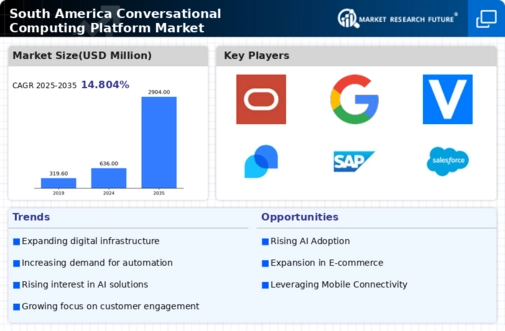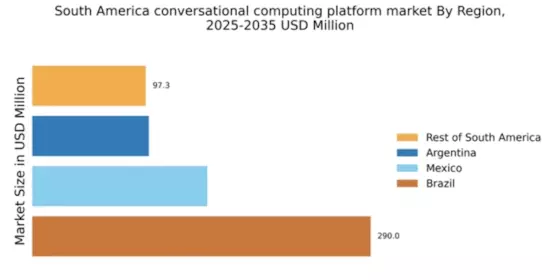Expansion of E-commerce
expansion of e-commerce in South America is significantly influencing the conversational computing-platform market. With online retail sales projected to grow by 20% annually, businesses are increasingly adopting conversational platforms to facilitate customer interactions and streamline the purchasing process. These platforms enable real-time communication, allowing customers to receive instant support and guidance while shopping online. As more consumers turn to digital channels for their shopping needs, the demand for effective conversational solutions is likely to rise. Companies that integrate these platforms into their e-commerce strategies can enhance user experience, reduce cart abandonment rates, and ultimately drive sales growth. This trend underscores the importance of conversational computing in the evolving retail landscape of South America.
Growing Internet Penetration
increasing internet penetration in South America is a pivotal driver for the conversational computing-platform market. As of 2025, approximately 75% of the population has access to the internet, which facilitates the adoption of digital solutions. This connectivity enables businesses to leverage conversational platforms to enhance customer engagement and streamline operations. The rise in smartphone usage, which stands at around 80% in urban areas, further supports this trend. Companies are increasingly investing in conversational computing technologies to meet the demands of a digitally savvy consumer base. This shift is likely to result in a more competitive landscape, as businesses that adopt these platforms can provide superior customer service and personalized experiences, thereby gaining a significant edge in the market.
Rising Consumer Expectations
Consumer expectations in South America are evolving rapidly, driving demand for more interactive and responsive customer service solutions. As consumers increasingly seek immediate assistance and personalized experiences, businesses are turning to conversational computing platforms to meet these demands. Surveys indicate that over 60% of consumers prefer interacting with chatbots for quick inquiries, highlighting a shift in customer service preferences. This trend is pushing companies to invest in sophisticated conversational technologies that can provide timely and relevant responses. the market is thus positioned to thrive as businesses strive to enhance customer satisfaction and loyalty. By adopting these platforms, companies can not only meet but potentially exceed consumer expectations, leading to increased market share and profitability.
Focus on Data Privacy and Security
As the conversational computing-platform market expands in South America, concerns regarding data privacy and security are becoming increasingly prominent. With regulations such as the General Data Protection Regulation (GDPR) influencing local policies, businesses are compelled to prioritize the protection of customer data. This focus on security is likely to drive the adoption of conversational platforms that incorporate robust data protection measures. Companies that can demonstrate compliance with privacy regulations and ensure secure interactions are more likely to gain consumer trust. As a result, the conversational computing-platform market may see a shift towards solutions that not only enhance user experience but also prioritize data security. This trend indicates a growing awareness of the importance of safeguarding personal information in the digital age.
Increased Investment in Technology
Investment in technology across South America is surging, which is likely to bolster the conversational computing-platform market. In 2025, technology investments in the region are projected to reach $50 billion, with a substantial portion directed towards AI and machine learning solutions. This influx of capital enables companies to develop and implement advanced conversational platforms that can handle complex customer interactions. Furthermore, government initiatives aimed at promoting digital transformation are encouraging businesses to adopt innovative technologies. As organizations recognize the potential of conversational computing to enhance operational efficiency and customer satisfaction, the market is expected to experience robust growth. This trend indicates a shift towards more automated and intelligent customer service solutions, positioning the conversational computing-platform market as a key player in the broader technology landscape.


















Leave a Comment